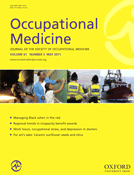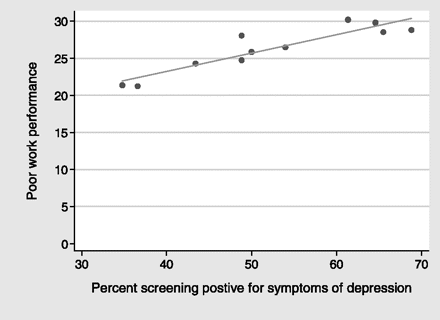-
PDF
- Split View
-
Views
-
Cite
Cite
S. B. Harvey, N. Glozier, M. Henderson, S. Allaway, P. Litchfield, K. Holland-Elliott, M. Hotopf, Depression and work performance: an ecological study using web-based screening, Occupational Medicine, Volume 61, Issue 3, May 2011, Pages 209–211, https://doi.org/10.1093/occmed/kqr020
Close - Share Icon Share
Abstract
Background Depression is reported to be a major cause of illness-related sub-optimal work performance (presenteeism). However, the majority of studies examining presenteeism have relied on self-report measures of work performance. Furthermore, employers currently face a number of practical challenges in attempting to facilitate early identification of depression.
Aims To test whether a web-based screening tool for depression could be used successfully in the workplace and whether it was possible to detect an association between rates of depression and objective measures of impaired workgroup performance.
Methods All permanent employees of a telecommunications company with UK-based call centres were encouraged to complete a web-based psychological assessment using the Patient Health Questionnaire depression scale (PHQ-9). In addition to confidential individual level results, the tool was able to provide anonymized summary statistics for each workgroup. Four objective measures of work performance were collected for each workgroup.
Results During the study period, 1161 web-based PHQ-9 questionnaires were completed. There was a negative linear relationship between rates of depressive symptoms and the overall performance of a workgroup (P < 0.001). The linear relationship between depression and workgroup performance remained after controlling for gender balance, percent of temporary staff, employees’ perceived level of engagement and satisfaction with their line manager (P < 0.01).
Conclusions Workgroups with high levels of depressive symptoms tend to perform poorly. Computer-aided web-based screening for symptoms of depression is feasible in a work setting.
Introduction
There are a number of reasons why depression may have an impact on occupational performance, including reduced concentration, fatigue, disturbed sleep and poor motivation [1–3]. To date, most of the research on presenteeism has relied upon self-report measures which ask employees to rate their own levels of productivity [4]. Like any self-report measure, these are prone to recall bias and confounding. Employers are increasingly being encouraged to facilitate early recognition of depression among their employees, but there are significant cost and feasibility concerns associated with wide scale mental health screening. Computer-aided screening tools may provide a solution to some of these practical concerns.
The aim of this study was to test whether a web-based screening tool for depression could be used successfully in the workplace and whether, using an ecological study design, it was possible to detect an association between symptoms of depression and objective measures of impaired workgroup performance.
Methods
An ecological study, in which the unit of observation is a group rather than individuals, was conducted within the UK call centres of a telecommunications company. All staff were encouraged to complete a web-based tool that identified possible sources of psychosocial adversity and measured symptoms using the Patient Health Questionnaire depression scale (PHQ-9). The PHQ-9 consists of nine questions relating to the key symptoms of depression, scored from 0 (not at all) to 3 (nearly every day), giving a total score out of 27 [5]. The PHQ-9 is a valid measure of depression symptoms, with scores <5 almost always signifying the absence of a depressive disorder [6].
Employees were able to access the tool in private via the company Intranet and were able to undertake repeat screening provided >1 month had passed since their prior assessment. Web-based assessments completed between January 2004 and July 2007 were used in this study. Individuals were given immediate feedback, with any PHQ-9 score of five or more generating a face to face meeting with either their line manager or a nominated alternative person. In addition to providing confidential individual level results, the tool was also able to provide anonymized summary statistics for each workgroup.
Within the company, four key aspects of call centre-based work performance are measured: number of senior consultations required, number of calls transferred, adherence (inverse percentage of the total online hours occurring compared with the total scheduled) and customer time (amount of call, wrap, offline and wait time as a percent of the scheduled hours plus overtime). For the purposes of this study, a measure of overall work performance was calculated as the average of these four percentages, with higher scores representing poorer performance. Mean performance scores for each workgroup were calculated during July 2007. To focus on presenteeism, only employees with no sickness absence during this month contributed to this calculation.
Information obtained from the company's human resources department was used to determine the demographics in each workgroup. The company also undertakes an annual survey of all its employees which provided measures of employees’ perceptions of their work, the organization and their line management.
Statistical analysis was performed using STATA computer software [7]. The association between group level measures of depressive symptoms and performance was initially assessed using univariate linear regression. Multivariable models were then constructed to examine the impact of the following potential confounding factors: gender, temporary versus permanent contract status, employee engagement and employees’ perception of their line manager. As this study utilized anonymized group level summary statistics of routinely collected data, specific ethical approval was not required.
Results
A total of 3401 permanent employees from 11 different workgroups were eligible to participate. During the study period, 1161 web-based PHQ-9 questionnaires were completed, indicating a response rate of 34%. The number of assessments in each of the 11 workgroups varied between 48 and 260, with an average of 106 PHQ-9 assessments in each workgroup. Of the completed assessments, 623 (54%) had scores of ≥5, indicating at least subclinical levels of depressive symptoms.
As demonstrated in Figure 1, there was a negative linear relationship between the proportion of respondents with depressive symptoms and the overall performance of that workgroup (P < 0.001). The linear relationship between depression and performance remained after controlling for gender, percent of temporary staff, employees’ perceived level of engagement and employees’ satisfaction with their line manager (Table 1).
Univariate and multivariable models of the association between group level measures of depression and work performance
| Model | Regression coefficient (95% confidence interval) | Standardized regression coefficient | P value |
| Univariate | |||
| Depression | 0.3 (0.2–0.3) | 0.9 | <0.001 |
| Multivariable | |||
| Depression | 0.2 (0.08–0.3) | 0.7 | <0.01 |
| Female gender | 0.1 (−0.01 to 0.2) | 0.3 | NS |
| Temporary contract | −0.02 (−0.07 to 0.04) | −0.1 | NS |
| Perception of line manager | 0.3 (−0.6 to −0.04) | −0.7 | <0.05 |
| Engagement with company | 0.1 (−0.2 to 0.4) | 0.3 | NS |
| Model | Regression coefficient (95% confidence interval) | Standardized regression coefficient | P value |
| Univariate | |||
| Depression | 0.3 (0.2–0.3) | 0.9 | <0.001 |
| Multivariable | |||
| Depression | 0.2 (0.08–0.3) | 0.7 | <0.01 |
| Female gender | 0.1 (−0.01 to 0.2) | 0.3 | NS |
| Temporary contract | −0.02 (−0.07 to 0.04) | −0.1 | NS |
| Perception of line manager | 0.3 (−0.6 to −0.04) | −0.7 | <0.05 |
| Engagement with company | 0.1 (−0.2 to 0.4) | 0.3 | NS |
NS, not significant. Regression coefficients are obtained from linear regression with poor workgroup performance as the dependent variable.
Univariate and multivariable models of the association between group level measures of depression and work performance
| Model | Regression coefficient (95% confidence interval) | Standardized regression coefficient | P value |
| Univariate | |||
| Depression | 0.3 (0.2–0.3) | 0.9 | <0.001 |
| Multivariable | |||
| Depression | 0.2 (0.08–0.3) | 0.7 | <0.01 |
| Female gender | 0.1 (−0.01 to 0.2) | 0.3 | NS |
| Temporary contract | −0.02 (−0.07 to 0.04) | −0.1 | NS |
| Perception of line manager | 0.3 (−0.6 to −0.04) | −0.7 | <0.05 |
| Engagement with company | 0.1 (−0.2 to 0.4) | 0.3 | NS |
| Model | Regression coefficient (95% confidence interval) | Standardized regression coefficient | P value |
| Univariate | |||
| Depression | 0.3 (0.2–0.3) | 0.9 | <0.001 |
| Multivariable | |||
| Depression | 0.2 (0.08–0.3) | 0.7 | <0.01 |
| Female gender | 0.1 (−0.01 to 0.2) | 0.3 | NS |
| Temporary contract | −0.02 (−0.07 to 0.04) | −0.1 | NS |
| Perception of line manager | 0.3 (−0.6 to −0.04) | −0.7 | <0.05 |
| Engagement with company | 0.1 (−0.2 to 0.4) | 0.3 | NS |
NS, not significant. Regression coefficients are obtained from linear regression with poor workgroup performance as the dependent variable.
Scatter plot with linear regression line demonstrating the relationship between depressive symptoms (percent of PHQ-9 scores ≥5) and workgroup performance (higher score represents poorer performance).
Discussion
Our study found that workgroups with higher levels of depressive symptoms had poorer work performance. To the best of our knowledge, this is the first time an independent association between depression and objective measures of workgroup performance has been demonstrated. The main strengths of this study are its novelty, its setting within a real work environment and the use of objective measures of work performance. However, there are some limitations. Completing the screening tool was not mandatory and some employees may have completed the screening more than once during the study period. While our measures of work performance were collected at the end of the study period, this does not remove the possibility of reverse causation: depressive symptoms occurring as a result of being in a poorly performing team. This study was ecological; thus, we are unable to determine whether depressive symptoms and poorer performance occur in the same individuals (the ‘ecological fallacy’). We also note that the PHQ-9 has not been validated in a workplace setting and is not equivalent to a clinical diagnosis of depression. Finally, while the measures of performance used were objective and similar to those used throughout this industry, they have not been validated more widely.
The rising costs associated with depression in the working population constitute a significant public health problem [8]. While we have demonstrated that computer-aided screening for depression is feasible, properly controlled trials are needed to fully evaluate the risks and benefits of any screening programme. One US-based trial did demonstrate that work-based screening for depression could result in improved clinical and work outcomes when paired with case management and facilitated access to treatment [9]. The feasibility of web-based assessments raises the prospect of linked computer-aided interventions in the workplace [10].
Workgroups with high levels of depression symptoms tend to perform poorly.
The link between depression and poor performance can be detected using objective measures of work performance.
Computer-aided web-based screening for symptoms of depression is feasible in a work setting.
Funding
This work is supported by Investors in People UK (IIPUK/R&D/ET/12/06). S.H., M.H. and M.H. are supported by the NIHR Biomedical Research Centre for Mental Health at the South London and Maudsley NHS Foundation Trust and Institute of Psychiatry, King's College London.
Conflicts of interest
None declared.
BT group (via PL) provided routinely collected data in the form of anonymized group level summary statistics for use in this study.




